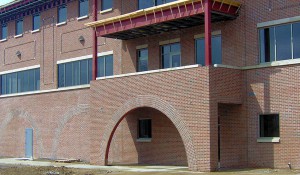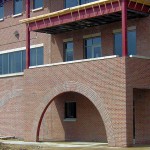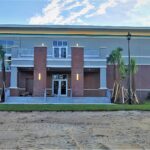Jacksonville Solid Masonry

EK Birken Masonry has offered brick construction services to customers in the Jacksonville area for more than 20 years. You can place your trust in our brick construction services because our masons have been trained in the best practices as defined by the Building Stone Institute (www.buildingstoneinstitute.org) and the Construction Specifications Institute (www.csinet.org).
For example, EK Birken Masonry takes the time to strike or tool the mortar joints of the brick, resulting in the cleanest, nicest looking finished product. The striking of a wall can make or break how the wall looks after it has been laid.
To make sure your project is not only completed within budget and schedule and lasts for decades, read further to see how EKB Masonry approaches a brick construction project to guarantee a beautiful and long-lasting structure.
Brick masonry is construction in which uniform units (“bricks”), small enough to be placed with one hand, are laid in courses with mortar joints to form walls. Bricks are kiln baked from various clay and shale mixtures. The chemical and physical characteristics of the ingredients vary considerably. These characteristics and the kiln temperatures combine to produce brick in a variety of colors and harnesses. In some regions, individual pits yield clay or shale which, when ground and moistened, can be formed and baked into durable brick. In other regions, clay or shale from several pits must be mixed.
Brick Terminology
Standard U.S. bricks are 2-1/4 x 3-3/4 x 8 inches nominal size. They may have three core holes or 10 core holes. Modular U.S. bricks are 2-1/4 x 3-5/8 x 7-5/8 inches nominal size. They usually have three core holes. English bricks are 3 x 4-1/2 x 9 inches; Roman bricks are 1-1/2 x 4 x 12 inches; and Norman bricks are 2-3/4 x 4 x 12 inches nominal size. Actual brick dimensions are smaller, usually by an amount equal to a mortar joint width. Bricks weigh from 100 to 150 pounds per cubic foot, depending on the ingredients and duration of firing. Fired brick is heavier than under-burned brick. The six surfaces of a brick are called cull, beds, side, end, and face, as shown below.

Occasionally you will have to cut brick into various shapes to fill in spaces at corners and other locations where a full brick does not fit. The image below shows the more common cut shapes: half or bat, three-quarter closure, quarter closure, king closure, queen closure, and split.

Types of Bricks
Brick masonry units may be solid, hollow, or architectural terra cotta. All types can serve a structural function, a decorative function, or a combination of both. The various types differ in their formation and composition.
Building brick, also called common, hard, or kiln-run brick, is made from ordinary clay or shale and is fired in kilns. These bricks have no special shoring, markings, surface texture, or color. Because building bricks are generally used as the backing courses in either solid or cavity brick walls, the harder and more durable types are preferred.
Face brick is better quality and has better durability and appearance than building brick. Because of this, face bricks are used in exposed wall faces. The most common face brick colors are various shades of brown, red, gray, yellow, and white.
Clinker brick is over burned in the kiln. Clinker bricks are usually rough, hard, durable, and sometimes irregular in shape.
Pressed brick is made by a dry-press process rather than by kiln firing. Pressed bricks have regular smooth faces, sharp edges, and perfectly square corners. Ordinarily, they are used like face brick.
Glazed brick has one surface coated with a white or colored ceramic glazing. The glazing forms when mineral ingredients fuse together in a glass-like coating during burning. Glazed bricks are particularly suited to walls or partitions in hospitals, dairies, laboratories, and other structures requiring sanitary conditions and ease of cleaning.
Fire brick is made from a special type of clay. This clay is very pure and uniform and is able to withstand the high temperatures of fireplaces, boilers, and similar constructions. Fire bricks are generally huger than other structural bricks and are often hand molded.
Cored bricks have 10 holes — two rows of five holes each — extending through their beds to reduce weight. Walls built from cored brick are not much different in strength than walls built from solid brick. Also, both have about the same resistance to moisture penetration. Whether cored or solid, use the more available brick that meets building requirements.
Strength of Brick Masonry
The main factors governing the strength of a brick structure include brick strength, mortar strength and elasticity, bricklayer workmanship, brick uniformity, and the method used to lay brick. In this section, we’ll cover strength and elasticity. Workmanship is covered separately in the next section.
The strength of a single brick masonry unit varies widely, depending on its ingredients and manufacturing method. Brick can have an ultimate compressive strength as low as 1,600 psi. On the other hand, some well-burned brick has compressive strength exceeding 15,000 psi.
Because portland-cement-lime mortar is normally stronger than the brick, brick masonry laid with this mortar is stronger than an individual brick unit. The load-carrying capacity of a wall or column made with plain lime mortar is less than half that made with portland-cement-lime mortar. The compressive working strength of a brick wall or column laid with plain lime mortar normally ranges from 500 to 600 psi.
For mortar to bond to brick properly, sufficient water must be present to completely hydrate the portland cement in the mortar. Bricks sometimes have high absorption rates and if not properly treated, can “suck” the water out of the mortar, preventing complete hydration. Here is a quick field test to determine brick absorptive qualities. Using a medicine dropper, place 20 drops of water in a 1-inch circle (about the size of a quarter) on a brick. A brick that absorbs all the water in less than 90 seconds will suck the water out of the mortar when laid. To correct this condition, thoroughly wet the bricks and allow time for the surfaces to air-dry before placing.
Bricklaying Methods
Good bricklaying procedures depend on good workmanship and efficiency. Efficiency involves doing the work with the fewest possible motions. Each motion should have a purpose and should accomplish a definite result. After learning the fundamentals, every builder should develop methods for achieving maximum efficiency. The work must be arranged in such a way that the builder is continually supplied with brick and mortar. The scaffolding required must be planned before the work begins. It must be built in such a way as to cause the least interference with other crewmembers.
Bricks should always be stacked on planks; they should never be piled directly on uneven or soft ground. Do not store bricks on scaffolds or runways. This does not, however, prohibit placing normal supplies on scaffolding during actual bricklaying operations. Except where stacked in sheds, brick piles should never be more than 7 feet high. When a pile of brick reaches a height of 4 feet, it must be tapered back 1 inch in every foot of height above the 4-foot level. The tops of brick piles must be kept level, and the taper must be maintained during unpiling operations.
Don’t see what you’re looking for, or have a question or issue that’s not covered above? See examples of EKB Masonry’s previous work by visiting our gallery, or contact us to discuss your next project.



